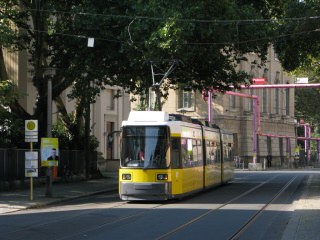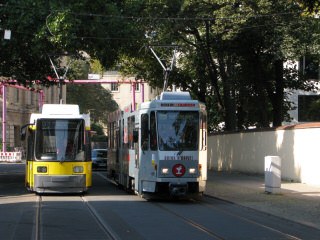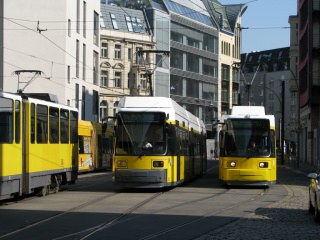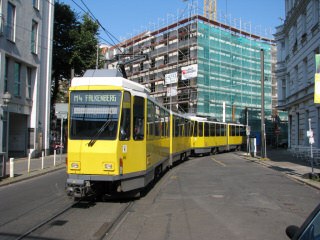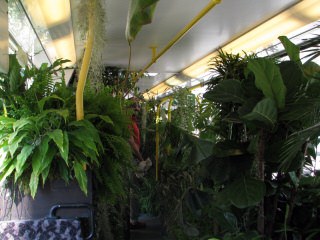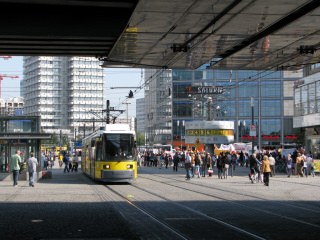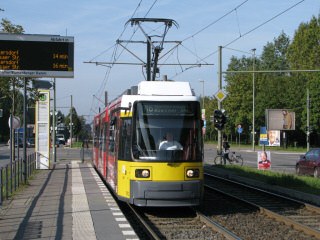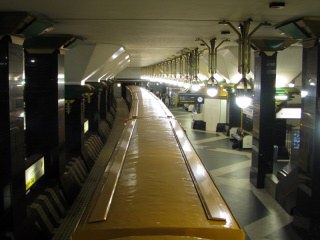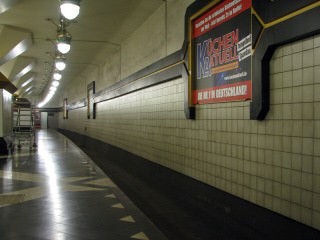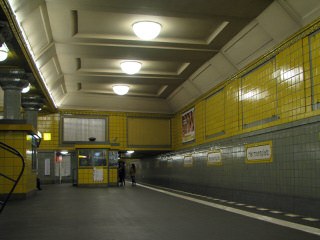budapest
other hungarian
close-up
lost rails
other countries
Trams and metros in Berlin, September 2011
Hier geht's zur deutschsprachigen Version / Kattints ide a magyar változathoz
This visit of to Germany's capital was more cultural and railway-oriented than usually, but of course I also managed to catch a few trams here and there.
I started at Kupfergraben, which is where trams get the closest to the historic center of Berlin currently. This terminus - opened in 1995 - is directly opposite to the famous Pergamon Museum. Only a single GT6N-ER was waiting for departure, when a strange silver tram appeared next to it: the "rolling pub", built out of a Tatra KT4D. Unfortunately it didn't stop, but at least I managed to catch it in the shadows.
Another inner-city terminus, only a few hundred meters away, at Hackescher Markt. This is a location I have seen many times on photos, but somehow I never had to time to go there. The platforms are in front of an elevated S-Bahn station, while trams wait for their departure in an encosed street nearby, sporting four tracks, as seen on the left. To the right: a KT4 double-set leaves the four-track fan to head first to the terminus platforms, and then to Falkenberg.
Miscellaneous public transit moments in Berlin, including
trams, buses, elevated U-Bahn and trains:
0:04- I could not help but to take a short clip of
this old river boat under this bridge
0:12- The same bridge seen from the dome of the Berlin
Cathedral. On the top of it we see a double-decker regional train on the
Stadtbahn - a railway line crossing right through the heart of Berlin
0:20- GT6N tram leaving the storage tracks of the Hackescher Markt terminus
0:31- One of the new Flexity trams arriving to the
platform of that terminus
0:39- Riding the Flexity
0:50- Riding a double-decker bus in former West-Berlin
0:58- The special heritage shuttle service between
the German Technology Museum (Deutsches Technikmuseum) and a depot
housing public transit vehicles
1:15- A heritage bus doing a shuttle between the same
two places
1:23- U12 train departing from the upper platform
of Gleisdreieck
1:37- The magnificent elevated section of U1 with
a bridge above the Landwehrkanal
1:51- A regional push-pull train passing by S-Bahn
station Bellevue
2:03- It's raining at Freidrichstrasse station...
and even though I was not in a singing mood, there was someone playing
"Singing in the rain" on trumpet :)
2:16- GT6N tram passing under Friedrichstrasse station
2:24- The temporary reversing triangle (wye) near Nordbahnhof. More about this a little later...
2:30- Another GT6N, somewhere in the vicinity of Marzahn
To the left: the interour of the pre-series unidirectional Bombardier "Flexity Berlin" low-floor tram (longer version). To the right: Karl-Liebknecht-Strasse - a mixture of different eras and cultures: GDR heritage, McDonald's, an old church, grassed tracks...
This Tatra T6A2mod was standing at the recently-built terminus at Alexanderplatz, with its interior converted into a greenhouse. I'm not really falling for these kind of artistic installations, but it was nice to see this type in the city, because these Tatras have been withdrawn years ago (this particular car - AFAIK - in 2002). "Metrotopie" or "Jungle tram" was an art project of Anne Duk Hee Jordan and Shira Wachsmann.
To the left: Alexanderplatz with the "World Clock" to the right in the background. To the left: the stop Landsberger Allee/Blumberger Damm.
99% of Berlin's tram lines run through ex-East-Berlin territories, and some of the streets and neighbourhoods can look quite alike. On these pictures: the stop Helene-Weigelt-Platz and its surroundings.
To the left: the construction of a new tramway line to the relatively new main railway station has started in 2011. Because of this, the trams running in Invalidenstrasse were cut back to a temporary reversing triangle at Nordbahnhof. To the right: the metro line U12 was the result of the renovation of the elevated section of the U2 line between Gleisdreieck and Wittenbergplatz: it was basically U1 switching over to U2's path to west of Wittenbergplatz. U2 was operating only north of Gleisdreieck, while U1 was running between Wittenbergplatz and Uhlandstrasse.
And while we're around this place, here's a video of
my favorite elevated stretch: the U1 metro line - during these months operating
as U12 - runs along the Landwehrkanal canal for a while, then it
crosses it between Möckernbrücke and Gleisdreieck. Underneath
there's a pedestrian bridge where once the railroad traffic to the Anhalter Railway Station was running, and even deeper there's also the tunnel of
the north-south S-Bahn. A very interesting piece of industrial archictecture
from every angle!
0:04- Water on water... with bridges above, and the
S-Bahn tunnel somewhere underneath the canal
0:13- A U12 train leaving the Gleisdreieck station through an illuminated portal between two buildings (this in fact
used to be one building, and the U-Bahn was runing through its facade).
0:21- Between Möckernbrücke and Hallesches
Tor
0:31- The section between Möckernbrücke and Gleisdreieck seen from the terrace of the German Technology Museum
(Deustches Technikmuseum)
1:01- The same section seen from underneath.
1:15- A train leaving for Hallesches Tor. Another
unseen feature is another metro station (for line U7) underneath the other
side of the canal!
Even more U-Bahn: the western terminus of the U7 line at Rathaus Spandau was opened in 1984. It features two tracks in the middle for U7 (left), and two tracks for a proposed but never built extension of the U2 line from Ruhleben to Falkenhagener Feld on both sides (one of them can be see on the picture to the right). This extension may never be built, because it was planned during the existence of the Berlin Wall, when the S-Bahn was operated by the East-German state railway company DR, and was therefore blockaded (avoided) by West-Berliners. Because of this blockade the S-Bahn was unprofitable, and the Spandau branch was even closed after a while (in 1980). In 1984 the S-Bahn lines in West-Berlin were transferred to the West-Berlin public transit operator BVG, but Spandau didn't get back its trains until way after the fall of the Berlin Wall (in1998 to be precize). The fact that the S- and the U-Bahn termini are not properly interconnected is quite possibly a remnant of the Wall days.
A few moments of underground (and elevated) railways
operating in Berlin:
0:04- Rathaus Spandau, terminus of U7
0:15- The elevated stretch of U1 between the stations Gleisdreieck and Möckernbrücke
0:25- Bundestag, the only intermediate station
of the "mini" U-Bahn line U55
0:32- A train of U5 running on the "wrong side" at Wuhletal due to maintenance works
0:42- U7's station at Hermannplatz - the part
where the ceiling is low, bears the station of the crossing metro line
U8
0:54- The anti-scratch/anti-graffiti mask found on
the windows features the silhouette of the Brandenburg Gate. It makes it
a bit uncomfortable to look out the windows, but I guess it's still better
than scratched/tagged windows.
1:01- U55 leaving the terminus Brandenburger Tor
And two more photos of the Hermannplatz station of U7. I quite like this station with the heigh ceiling and the U8 line crossing it in the middle in that closed pit. And of course the glazed tiles that are so characteristic for Berlin!
And that's it for now...
Back to the top Back to the main page
